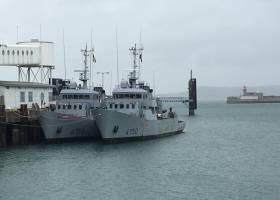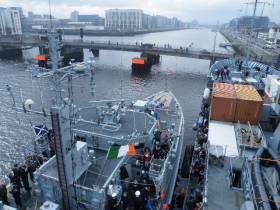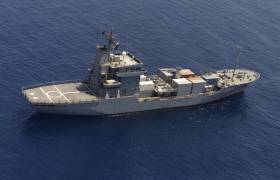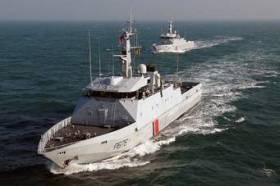Displaying items by tag: Naval Visits
#FrenchNavy - A pair of French Navy trainee vessels visited Dun Laoghaire Harbour while all the attention focused on the NATO flotilla to neighbouring Dublin Port last weekend, writes Jehan Ashmore.
It was a busy scene as hundreds of visitors flocked to the NATO six-strong flotilla on the Liffey beside the East-Link Bridge. In stark contrast across the bay in Dun Laoghaire, French Navy vessels Tigre and Jaguar were berthed without the attention that a NATO call can draw, largely due to media coverage.
Senior French naval ratings were welcomed from the two Leopard class vessels at a reception held in the Harbour Lodge of the Dun Laoghaire Harbour Company.
Each of the 335 tonnes vessels docked at berth No. 3 along St. Micheal’s Pier where the ‘former’ ferry terminal is available to let as previously reported on Afloat.
At this berth is also located the harbour’s only suitable ferry berth linkspan (see photo). The facility is to the left of the naval vessels but cannot be seen in the above photo.
On the adjacent side of St. Michaels Pier, is berth No. 4, where a linkspan (now redundent) was custom-built to handle the specialist berthing requirements of the HSS Stena Explorer. The fast-ferry was withdrawn from the Holyhead route following Stena’s closure of the service in 2014.
NATO Vessels in Dublin Port Open to Public Over Weekend
#NATOdublin - Following Afloat's report yesterday on the arrival of a NATO flotilla to Dublin Port, the Irish Times writes that the six ships will be open for viewing to the public over the weekend.
The ships, attached to Standing Nato Mine Counter Measures Group 1, will be berthed in Dublin until Monday at 10am. All ships will be open to visitors on Saturday and Sunday between 2pm and 4pm beside the East-link bridge.
The fleet engages in minehunting exercises, which involves dealing with historic maritime weaponry such as unexploded bombs, torpedoes, shells and mines from the two World Wars.
The fleet is part of the “enhanced high readiness Nato Reaction Force” and provides a “crucial element to Nato’s capabilities in area access and area denial operations”, according to the organisation.
The newspaper has more, click here to read.
NATO Naval Minehunter Flotilla Dock in Dublin Port
#NATOdublin - In this historic week of the Easter Monday 1916 Rising Centenary and backdrop of World War I, a flotilla of NATO vessels among them from the UK and Germany docked in Dublin Port this morning, writes Jehan Ashmore.
The North Atlantic Treaty Organisation (in which Ireland is not a member) naval exercise group is on a four-day visit to the capital.
Of the six-strong Standing NATO Mine Counter Measures Group 1, the UK is represented by the Royal Navy Sandown-class minehunter HMS Ramsey, usually based in Faslane.
Earlier this year the minehunter transited the 98-kilometre Kiel canal. It was at Kiel that the sailors attended a ceremony which saw the German Navy and Commander Martin Schwarz of flagship FGS Donau take charge of the minehunter group – one of two operated by NATO in European waters.
FGS Donau is an 'Elbe' class auxiliary and supplies vessel which led the NATO fleet into Dublin Bay last night to anchor. The 3,500dwt tonnes replenishment vessel was joined by fleetmate minehunter FGS Dillingen.
According to ‘The Sea and The Easter Rising’ by the late Dr. John de Courcy Ireland, it was during 1914 that the Germans captured the Norwegian owned, Wilson Liner freighter Castro. The cargoship was converted into a naval auxiliary cruiser as the S.M.S. Libau (pseudo S.S. Aud) for her arms shipment role from Lubeck to its scuttling off the Daunt Rock.
The other NATO navies vessels are Vlaardingen (Netherlands) Primula (Belgium) and Otra from Norway. They are also berthed in Dublin Port with their German counterparts near the East Link Bridge at the North Quay Wall Extension.
It is the task of NATO fleet to practise minehunting collectively so they can respond to any crisis as well as to conduct exercises dealing with historic ordnance such as bombs, unexploded torpedoes, shells and mines from the two World Wars.
The Mine warfare operations of NATO’s Alliance Strategy is to provide a crucial contribution to each and to take an integral and vital role in all maritime and joint operations.
Flamingo Flies French Tricolor In Advance of Patrick's Day
#FrenchNavy– PSP Flamant (P676) a French Navy fisheries and coastguard patrol vessel docked in Dublin Port in advance of celebrating tomorrow's St. Patrick’s Day, writes Jehan Ashmore.
The OPV54 or 'Cormoran' bird class Flamant flying the 'tricolor' (adopted during the French Revolution) departed her homeport of Cherbourg and docked in the Irish capital this morning. It took two days for the 22 knot capable vessel to reach Dublin Bay where the naval visitor was greeted by the Liffey, a port pilot cutter.
A crew of just 20 personnel including tree trainees sailed upriver to the city centre at Sir John Rogersons Quay. Further along the south quays is O’Connell Bridge to where tomorrow’s largest St. Patrick's festival parade is to cross the Liffey to much fanfare in this centenary year of the 1916 Rising.
Flamant is to remain in port till Saturday morning and return to waters where the vessel is principally tasked in patrolling and surveillance duties in the zone économique exclusive (ZEE).
The OPV built by Constructions Mécaniques de Normandie also located in Cherbourg is from where the vessel sets off on these ZEE patrols. This involves patrols extending to 200 nautical miles offshore into the Atlantic Ocean.
She is equipped with a RIB concealed in a dock well which is accessed from a stern-lifting door.
French Anti-Submarine Frigate Visits Dublin Port
#FrenchFrigate- A French Navy anti-submarine frigate, Jean de Vienne (D 643) of the Type F 70 class docked in Dublin Port this morning, writes Jehan Ashmore.
Upon arrival in the channel fairway the 3,800 tonnes displacement frigate was assisted by port tug sisters, Beaufort and Shackleton.
The 139 metre long frigate which is on a four-day visit is the first foreign naval caller to the capital this year.
Jean de Vienne entered service more than three decades ago in 1984 and has a crew of more than 250.
Note the frigate's pennant number (D 643) and use of the letter 'D'. This is because the French navy does not use the term "destroyer" so some larger ships referred to as "frigates", are registered as destroyers.
Among her armament are Exocet and Crotale missiles.
Propulsion for the frigate is from a combined diesel or gas (CODOG) system which generates 21 knots when in diesel mode and 30 knots from gas.
On Tuesday around midday, Jean de Vienne is scheduled to depart.
#JointNavyPatrols – The Spanish Navy currently has 29 ships at sea, and 2,665 people embarked or deployed away from their bases. One of these ships the offshore patrol vessel, Arnomendi (P63) is understood to have completed in an international pelagic monitoring campaign off Ireland, writes Jehan Ashmore.
The ‘Chilreu’ class OPV Arnomendi has been to the Great Sole Bank, off the south of Ireland for the second stage of a pelagic monitoring campaign where a four-nation team participated with naval OPV’s from Ireland, the UK, France and Spain.
The campaign's purpose was to enhance and improve control, inspection and surveillance standards and help establish the coordination of these activities among member states. The origins of the international pelagic campaign were formed from the Fisheries Surveillance Plan that was drafted in 2014.
During this second stage of the campaign deployment, Arnomendi with a crew of 37 was scheduled to embark one Irish and two Spanish fishery inspectors in the port of Cork.
The 1,962 displacement vessel which has a stern mounted heli-deck has since returned to Cork's J.J. Horgans Wharf in recent days, however the OPV is scheduled to depart tonight and is expected to reach her homeport of Cartagena by October 10th.
Prior to her role in the Atlantic, the 66m long Arnomendi had departed Cartagena to take part in the first stage of the pelagic campaign in the Cantabrian Sea that ran for a fortnight. This involved the OPV built in 2000 act as ‘core-ship’ in the joint naval deep-sea fishing campaign held in international waters off the coasts of France, Portugal and those within the Spanish EEZ.
The naval flotilla had carried out tasks including the verification of authorized trawlers, the implementation of existing fishing regulations and prevention of illegal activities by third party elements.
The above duties also required the assistance of inspectors to board both Iberian navies, one from the Spanish fisheries secretariat, SEGEPESCA and the other from the Portuguese Natural Resources Secretariat.
It is appropriate that the OPV which is the second of the Chilreu trio class, whose main mission is surveillance and fishing control, was designed from the hull of a trawler, the Trimbel. This vessel was commissioned by the Ministry of Agriculture and Fisheries to assist the Spanish Navy's Chilreu class patrol boats in surveillance missions after the so-called “Turbot War”.
Each of the sisters main armoury consist of a pair of Browning 12.7 mm machine-guns and a single 1 MG-42 (7.62 mm) gun.
In addition to the standard crew total, the vessel can accommodate a 16-strong Marine Corps contingent. Also mentioned was the heli-deck which is for the use of light helicopters, the AB-212 or H-500.
German Corvette Cancels Dun Laoghaire Visit Diverts to Dublin
#GermanCorvetteCancels – A German Navy corvette due to make a four-day visit to Dun Laoghaire Harbour including as previously reported, scheduled public tours this weekend have been cancelled, writes Jehan Ashmore.
According to the ships agent, the 1,850 tonne corvette FGS Ludwigshafen am Rhein (F264) had sought the supply of fenders to meet the requirement of the 90m long vessel alongside Carlisle Pier. It is understood that such fenders were due to be installed but will not be ready in time for the naval visitor.
The Carlisle Pier is where in recent years small sized cruiseships have berthed, notably the largest and most frequent caller is the sail-assisted five-mast 310 passenger Wind Surf of 14,745 tonnes.
Instead of calling to Dun Laoghaire, the FGS Ludwigshafen am Rhein, the final member of five ‘Braunschweig’ class corvettes is to divert to Dublin Port with an arrival tomorrow (Friday) morning.
Some four hours later, Dublin Port welcomes a second foreign naval caller, the UK’s HMS Dauntless (D33), one of the most modern high-tech destroyers currently in service for the Royal Navy.
Due to unforeseen circumstances German Navy #LuwigshafenAmRhein will not visit @dlharbour this weekend. Apologies for inconvenience
— DúnLaoghaire Harbour (@DLHarbour) September 24, 2015UK’s Most Modern ‘Daring’ Class of Destroyer to Dock in Dublin
#DaringDestroyer – One of the most modern high-tech UK naval destroyer's, the Type 45 HMS Dauntless (D33) is to make a first visit to Dublin Port this weekend, writes Jehan Ashmore.
Afloat understands this will be the first ever visit of a Type 45 destroyer to the Republic and follows last year’s visit of a sister HMS Duncan which made an inaugural visit to Belfast, her adopted city.
The 152m long ‘Daring’ class destroyer displacing 8,000 tonnes has a striking stealth superstructure to reduce radar signature detection likewise of a the smaller Dutch class frigate which paid a recent visit.
HMS Dauntless has an impressive array of weapons, and is notable as the first Daring class destroyer to fire the new Sea Viper missile, despite been the second in the series to be commissioned in 2010.
The Sea-Viper Missiles are the principal anti-air missile system which provides all-round defence – not just for the destroyer but for an entire naval task group. The system is to be used against all aerial threats some 70 miles away. In addition the missiles race towards its target at speeds in excess of Mach Four (over 3,000mph) using a series of tiny jets to manoeuvre, carrying out sharp turns at G forces no human could endure.
Another weapons system is the Phalanx, one of the most deadly last lines of defence for the Royal Navy. Phalanx is capable of engaging targets around one mile away, it is a radar-controlled Gatling gun which fires 20mm shells, spewing out 3,000 rounds a minute.
Mounted on the forecastle is a MK8 Gun which is featured on all Royal Navy destroyers and frigates.
She is also equipped with a Sampson radar, which is a sophisticated multi-function radar, an essential part of the air defence system for the Type 45.
Destroyers such as HMS Dauntless which has a crew of 180 can also take 60 troops and together they play an integral part in forming the backbone of the Royal Navy, committed around the world 365 days a year hunting pirates, drug runners or submarines, defending the Fleet from air attack.
In May, HMS Dauntless returned to her homeport, Portsmouth following a deployment to the Gulf in the Middle East where she spent the bulk of her time supporting US carrier operations in the on-going struggle against the fundamentalists of Isis.
In her breaks between providing air defence for US Navy flat-tops, HMS Dauntless visited Kuwait, Dubai plus Abu Dhabi and Bahrain, hub of RN operations in the Middle East.
During the four month deployment, HMS Dauntless sailed more than 47,000 miles, providing crucial support to Charles De Gaulle’s strike operations against ISIL – and before her USS Carl Vinson.
The aircraft carrier conducted maritime security patrols, reassuring the merchant traffic that the world depends on global trade.
The destroyers also participate in providing humanitarian aid after natural disasters. In such conditions the role of the stern flight deck is aided by a Chinook helicopter.
Cruiseship Sets a Course for Visit of German Corvette to Dun Laoghaire
#GermanCorvette - Following German cruiseship caller Mein Schiff 4 offshore of Dun Laoghaire Harbour yesterday, the port this month is to welcome a corvette also from the same country, writes Jehan Ashmore.
The 90m long 1,850 tonne German Navy vessel ‘Ludwigshafen am Rhein’ (F264), is the final of five ‘Braunschweig’ class corvettes that was commissioned into service in 2013.
She is to pay a four-day visit to the harbour from the 25th-28th September. During next weekend the corvette will be open to the public at the Carlisle Pier on Saturday 26th (13:00 – 17:00) and on Sunday 27th (14:00 – 16:00).
It should also be noted that another German naval visitor, Gorch Fock, a sail trainee ship is currently nearing the end of visit to Dublin Port that began more than a fortnight ago. Also berthed at Sir John Rogersons Quay is an expedition luxury motoryacht, M.Y Turmoil built in 2006 that arrived from Cork today.
She is a stark contrast to the 1958 built tallship which as previously reported on Afloat is to have a second ‘Open Ship’ for the public held tomorrow, Sunday (20th September).
Tours of the three-masted sail barque are between 14:00-17:00, and where her crew will welcome you on board.
So why not make a visit (free of charge and no registration) to the vessel that has made an impressive 168 cruises.
Gorch Foch is to depart next week, on the Monday when she sets sails to Funchal, Portugal. A further call on the Iberian Peninsula is to take her to Cadiz in neighbouring Spain.
The final leg of this cruise is to involve a return crossing of the Bay of Biscay in November with the final leg from Dartmouth to Wilhelmshaven back in Germany.
Dutch Navy Frigate Tours 'Fully Booked' On Visit to Dublin
#FrigateBookedUp-Since our coverage yesterday of the visit to Dublin Port of the Royal Netherlands Navy air-defence and command frigate HNLMS De Zeven Provinciën (F802), the Dutch Embassy has advised that tours on a first come served basis for this Saturday (12 September) have now been fully booked.
The ‘Provinciën’ class fast-frigate (30 knots) has weaponry that includes Enhanced Sea Sparrow missiles and is the leadship of a quartet commissioned in 2002. The striking looking 6,050 tonnes frigate with its stealth designed superstructure of sharp angles is to reduce radar signature.
Vantage points of the frigate berthed at Ocean Pier can be seen from the R131 road (East-Link bridge) along the southquays that leads to the Poolbeg Boat, Yacht Club & Marina located in Ringsend.


































































